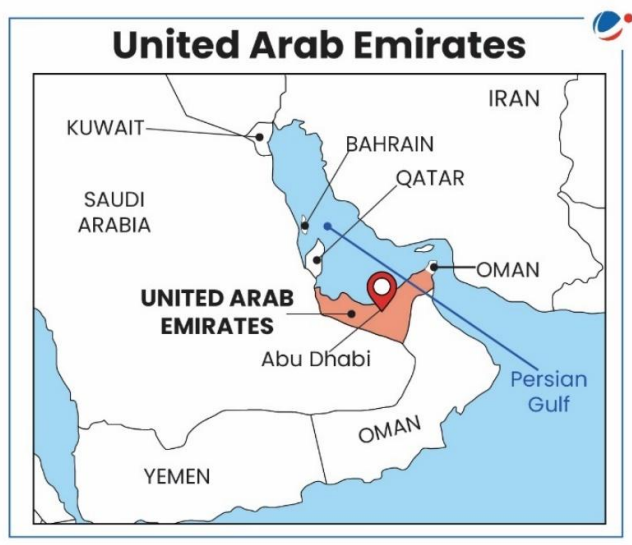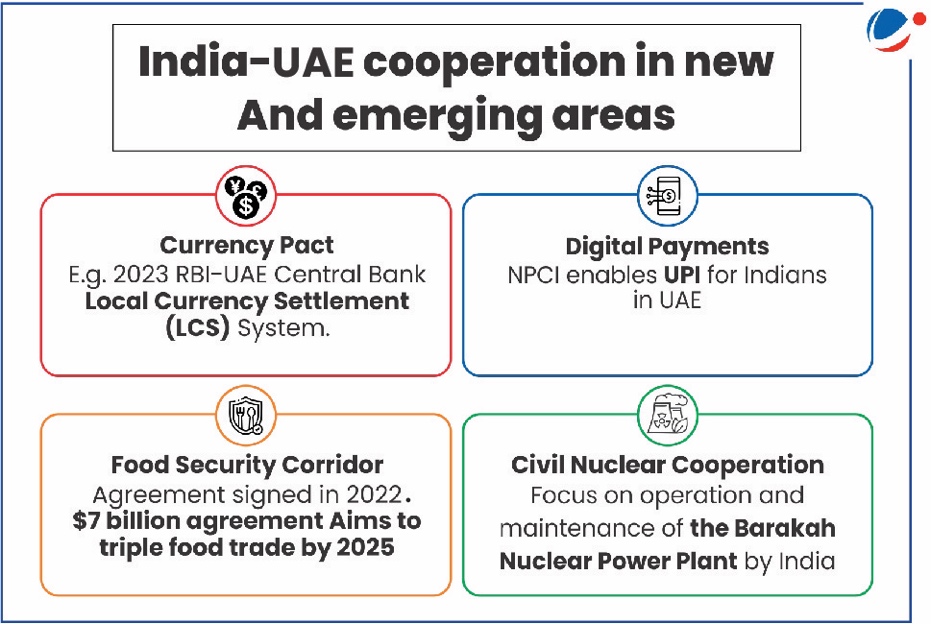Why in the News?
The recent visit of Crown Prince of Dubai, was his first official to India.
Key Announcements during the visit

- Bharat Mart & Virtual Trade Corridor (VTC): To boost bilateral trade and strengthen the India-Middle East-Europe Economic Corridor (IMEEC).
- The Bharat Mart is India's warehousing facility which would help the Indian exports showcase their products under one roof. This is similar to China's Dragon Mart.
- Ship Repair Clusters (Kochi & Vadinar): Expected to enhance India's maritime sector with global best practices.
- Other Initiatives: India-UAE Friendship Hospital (in Dubai), IIM Ahmedabad's Dubai campus and Dubai Chamber of Commerce's India office to further deepen economic collaboration.
Significance of Bilateral Relations
For Both Countries
- Growing Political Relationship: Since PM's 2015 visit—first in 34 years—relations have significantly deepened, from what used to be a buyer-seller relationship into a Comprehensive Strategic Partnership (2017).
- UAE was invited as a Guest Country (only 9 guest countries were invited) to the G20 Summit held under India's Presidency.
- Strategic Global Partnership: Both countries actively engage in key international groupings such as BRICS, I2U2 (India-Israel-UAE-USA), and the UAE-France-India (UFI) Trilateral.
- India-UAE's Expanding Role in Regional Cooperation:
- India-Middle East Economic (IMEEC) Corridor: The Agreement for an Intergovernmental Framework on the India-Middle East Economic Corridor facilitates multilateral cooperation between India and the UAE.
- Indian Ocean Naval Symposium (IONS): Both collaborate to ensure free sea lanes.
- Naval Engagements & Joint Exercises: Bilateral drills, e.g., Gulf Star 1 and PASSEX, alongside Desert Cyclone (India-UAE) and trilateral Desert Knight (India-France-UAE), strengthen maritime cooperation.
For India
- UAE's Pivotal Role as India's Key Energy Partner: For instance, UAE is India's 4th largest source of crude oil and the 2nd largest source of LNG & LPG.
- Strategic Oil Reserves: UAE is the only nation in the region to offer to store strategic oil reserves in India.
- Robust Trade Relations: For instance, Bilateral trade reached $85 billion (2022-23), with India exporting goods worth approximately $32 billion.
- It makes the UAE India's 3rd largest trading partner and 2nd largest export destination.
- Deepening Economic Integration & Investment: UAE is the only country with which India has both a trade agreement—CEPA, 2022—and an investment agreement—Bilateral Investment Treaty (BIT, 2023).
- Comprehensive Economic Partnership Agreement (CEPA) target: To take bilateral non-oil trade to USD 100 billion level by 2030.
- Also, UAE is the 7th largest in the total FDI received in India (2000- 2024).
- Strengthening People-to-People and Cultural Ties: The Indian expatriate community in the UAE numbers approximately 3.5 million, making it the largest ethnic group in the country.
- Remittances: The UAE was a key contributor to India's remittance inflows in FY24, accounting for 19.2% (approximately $11.7 billion) of the total.
- Cultural Milestone: 'BAPS Mandir', first Hindu temple in UAE, is the largest of its kind in the Gulf region.
For UAE
- India as a Major Destination for UAE Investments: For instance, India accounts for approximately 5% of UAE's total Overseas Direct Investments (2000 – 2024).
- UAE'S Enhanced Market Access under CEPA: E.g., Tariff reductions/eliminations on over 80% of products entering India from UAE.
- For instance, Following CEPA, UAE's exports to India rose by 7%.
- India Provides Food Security: As UAE's agricultural vulnerability—only 0.7% arable land—makes it highly dependent on food imports, India (extensive agricultural base) is a natural partner.
- E.g., Platforms like Agriota, links Indian farmers directly with UAE markets.
Challenges in India-UAE relationship

- Migration and Labor Issues: The UAE's Kafala system has been criticized for contributing to labor abuses and forced labor.
- The Kafala system is a sponsorship-based labor system in Gulf countries, where employers have control over foreign workers' legal status, including their visas and employment conditions.
- Trade Imbalances: In FY 2022, the India's trade deficit with UAE reached US$16.78 billion.
- Energy Pricing and OPEC Disagreements: As an OPEC member, the UAE supports policies that may not align with India's stance as a major oil importer, especially when it comes to controlling oil prices.
- Air Services Agreement Disputes: The UAE wants to increase the number of flights and destinations to India, but India has limited the expansion to protect its domestic airlines.
- Regional Crises: The war in Gaza and Houthi attacks in the Red Sea have affected some regional cooperation, including the India-Middle East Corridor.
- India-Iran vs. UAE-China Dynamics: India's strategic relationship with Iran, especially over regional security and energy interests, can sometimes clash with the UAE's growing ties with China.
Conclusion
India-UAE relations have evolved into a strategic partnership, marked by strong trade ties and cooperation. However, challenges like geopolitical balancing, energy debates, and labor concerns must be navigated carefully.



